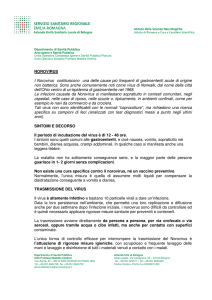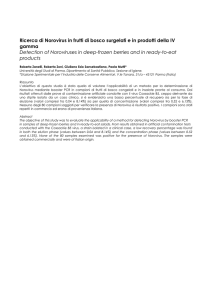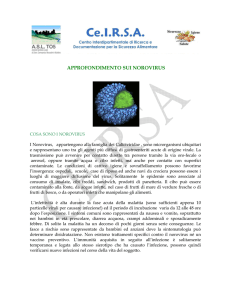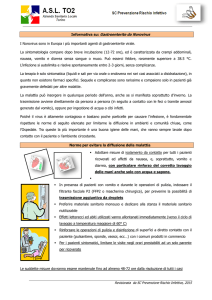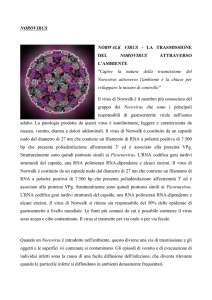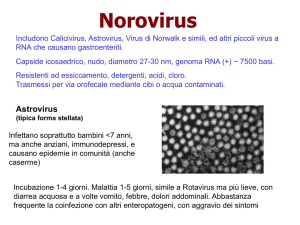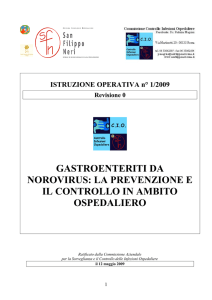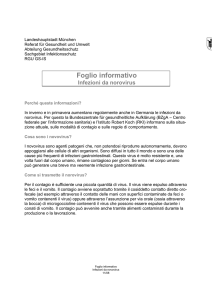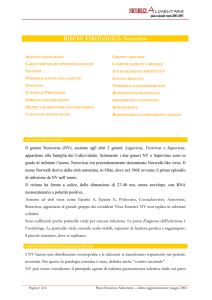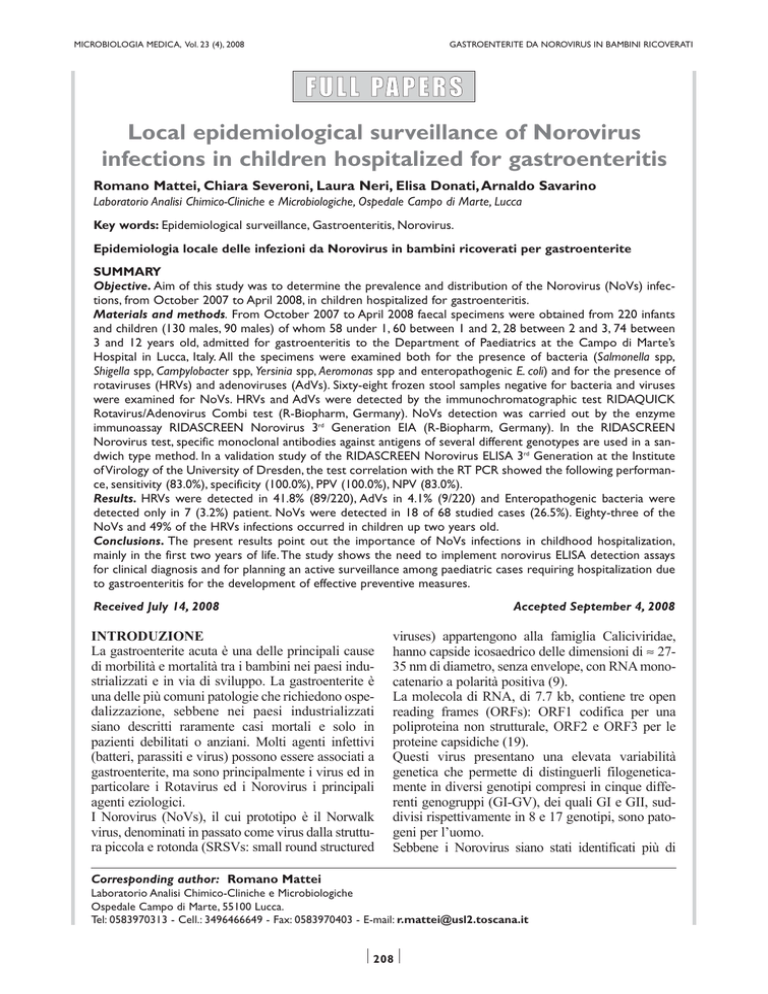
MICROBIOLOGIA MEDICA, Vol. 23 (4), 2008
GASTROENTERITE DA NOROVIRUS IN BAMBINI RICOVERATI
F U L L PA P E R S
Local epidemiological surveillance of Norovirus
infections in children hospitalized for gastroenteritis
Romano Mattei, Chiara Severoni, Laura Neri, Elisa Donati, Arnaldo Savarino
Laboratorio Analisi Chimico-Cliniche e Microbiologiche, Ospedale Campo di Marte, Lucca
Key words: Epidemiological surveillance, Gastroenteritis, Norovirus.
Epidemiologia locale delle infezioni da Norovirus in bambini ricoverati per gastroenterite
SUMMARY
Objective. Aim of this study was to determine the prevalence and distribution of the Norovirus (NoVs) infections, from October 2007 to April 2008, in children hospitalized for gastroenteritis.
Materials and methods. From October 2007 to April 2008 faecal specimens were obtained from 220 infants
and children (130 males, 90 males) of whom 58 under 1, 60 between 1 and 2, 28 between 2 and 3, 74 between
3 and 12 years old, admitted for gastroenteritis to the Department of Paediatrics at the Campo di Marte’s
Hospital in Lucca, Italy. All the specimens were examined both for the presence of bacteria (Salmonella spp,
Shigella spp, Campylobacter spp, Yersinia spp, Aeromonas spp and enteropathogenic E. coli) and for the presence of
rotaviruses (HRVs) and adenoviruses (AdVs). Sixty-eight frozen stool samples negative for bacteria and viruses
were examined for NoVs. HRVs and AdVs were detected by the immunochromatographic test RIDAQUICK
Rotavirus/Adenovirus Combi test (R-Biopharm, Germany). NoVs detection was carried out by the enzyme
immunoassay RIDASCREEN Norovirus 3rd Generation EIA (R-Biopharm, Germany). In the RIDASCREEN
Norovirus test, specific monoclonal antibodies against antigens of several different genotypes are used in a sandwich type method. In a validation study of the RIDASCREEN Norovirus ELISA 3rd Generation at the Institute
of Virology of the University of Dresden, the test correlation with the RT PCR showed the following performance, sensitivity (83.0%), specificity (100.0%), PPV (100.0%), NPV (83.0%).
Results. HRVs were detected in 41.8% (89/220), AdVs in 4.1% (9/220) and Enteropathogenic bacteria were
detected only in 7 (3.2%) patient. NoVs were detected in 18 of 68 studied cases (26.5%). Eighty-three of the
NoVs and 49% of the HRVs infections occurred in children up two years old.
Conclusions. The present results point out the importance of NoVs infections in childhood hospitalization,
mainly in the first two years of life. The study shows the need to implement norovirus ELISA detection assays
for clinical diagnosis and for planning an active surveillance among paediatric cases requiring hospitalization due
to gastroenteritis for the development of effective preventive measures.
Received July 14, 2008
Accepted September 4, 2008
INTRODUZIONE
La gastroenterite acuta è una delle principali cause
di morbilità e mortalità tra i bambini nei paesi industrializzati e in via di sviluppo. La gastroenterite è
una delle più comuni patologie che richiedono ospedalizzazione, sebbene nei paesi industrializzati
siano descritti raramente casi mortali e solo in
pazienti debilitati o anziani. Molti agenti infettivi
(batteri, parassiti e virus) possono essere associati a
gastroenterite, ma sono principalmente i virus ed in
particolare i Rotavirus ed i Norovirus i principali
agenti eziologici.
I Norovirus (NoVs), il cui prototipo è il Norwalk
virus, denominati in passato come virus dalla struttura piccola e rotonda (SRSVs: small round structured
viruses) appartengono alla famiglia Caliciviridae,
hanno capside icosaedrico delle dimensioni di ≈ 2735 nm di diametro, senza envelope, con RNA monocatenario a polarità positiva (9).
La molecola di RNA, di 7.7 kb, contiene tre open
reading frames (ORFs): ORF1 codifica per una
poliproteina non strutturale, ORF2 e ORF3 per le
proteine capsidiche (19).
Questi virus presentano una elevata variabilità
genetica che permette di distinguerli filogeneticamente in diversi genotipi compresi in cinque differenti genogruppi (GI-GV), dei quali GI e GII, suddivisi rispettivamente in 8 e 17 genotipi, sono patogeni per l’uomo.
Sebbene i Norovirus siano stati identificati più di
Corresponding author: Romano Mattei
Laboratorio Analisi Chimico-Cliniche e Microbiologiche
Ospedale Campo di Marte, 55100 Lucca.
Tel: 0583970313 - Cell.: 3496466649 - Fax: 0583970403 - E-mail: [email protected]
208
MICROBIOLOGIA MEDICA, Vol. 23 (4), 2008
MATTEI R, SEVERONI C, NERI L, et al
trenta anni fa, le conoscenze del loro ciclo replicativo
ed i meccanismi di patogenicità sono state limitate
dall’impossibilità di coltivare questi virus in linee cellulari e di riprodurre l’infezione in modelli animali.
Solo recentemente Straub et al, hanno riportato che
ceppi di norovirus umani possono infettare e replicarsi in un modello tridimensionale di coltura cellulare
derivata da epitelio intestinale umano (41), e nel lavoro di Guix et al, per la prima volta si riporta che i
norovirus isolati da feci di volontari possono essere
coltivati in cellule di epatoma umano con espressione di antigeni virali, replicazione e rilascio delle particelle virali nel medium (20).
Identificati per la prima volta nel 1972 come causa
della cosiddetta “winter vomiting disease” (24, 1,
14), i Norovirus sono causa di gastroenterite caratterizzata da nausea, vomito, crampi addominali,
diarrea associate occasionalmente a cefalea, dolori
muscolari e febbre (4, 43). Il periodo d’incubazione
varia fra 10 e 48 ore ed in genere la malattia si risolve in 36-48 ore. I casi documentati di diarrea protratta e di serie complicanze sono rari e si verificano quasi esclusivamente in pazienti anziani o immunodepressi (4, 33).
I Norovirus hanno una distribuzione cosmopolita,
sono una causa frequente di gastroenterite epidemica negli adulti (25) e dopo i Rotavirus sono la più
importante causa di gastroenterite virale nei bambini (35, 39, 34, 38). Sono causa di epidemie soprattutto in comunità chiuse quali case di cura (25, 18),
ospedali (11, 5, 40, 23), navi da crociera (21, 27, 22)
e dormitori (3) ed inoltre sono riconosciuti responsabili della diarrea del viaggiatore in pazienti di tutte
le età (26, 29, 12). Il serbatoio principale dei norovirus è l’uomo. Sono altamente contagiosi essendo
la dose minima infettante inferiore a 100 particelle
virali (36). Le modalità di trasmissione includono il
consumo di cibo e bevande contaminati (2, 15, 32,
44, 46), il contatto con superfici contaminate e la
trasmissione per via aerea a seguito della formazione di aerosol a partire dagli episodi di vomito (6,
11). È stato infatti stimato che un singolo incidente
di vomito può generare da 300 a 3000 dosi infettanti di virus (10). L’immunità che segue l’infezione ha
breve durata e non conferisce protezione nei confronti di successive infezioni, probabilmente a causa
della variabilità genetica del virus. Tale variabilità è
ascrivibile a meccanismi evolutivi del virus, tutt’oggi sconosciuti, che governano la persistenza e la
comparsa di nuovi ceppi epidemici nella popolazione umana (30, 31, 28, 13, 7, 37, 38).
MATERIALI E METODI
Nel periodo compreso fra ottobre 2007 e aprile
2008, sono stati raccolti campioni di feci da 220
pazienti pediatrici (130 maschi, e 90 femmine), di
cui 58 con meno di un anno, 60 con età compresa tra
1 e 2 anni, 28 tra 2 e 3 anni e 74 tra 3 e 12 anni, ricoverati per gastroenterite presso il reparto di Pediatria
dell’Ospedale Campo di Marte di Lucca. Su tutti i
campioni di feci è stato eseguito sia l’esame colturale per la ricerca dei principali batteri (Salmonella
spp, Shigella spp, Campylobacter spp, Yersinia spp,
Aeromonas spp ed E. coli enteropatogeni), sia la
ricerca degli antigeni virali di Rotavirus (HRVs) e
Adenovirus (AdVs). Sessantotto campioni di feci
risultati negativi all’esame colturale per batteri e
virus sono stati congelati e successivamente esaminati per la ricerca dei NoVs.
Gli antigeni virali dei HRVs e AdVs sono stati ricercati con il test immunocromatografico RIDAQUICK Rotavirus/Adenovirus Combi test (RBiopharm, Germany).
La ricerca dei NoVs è stata eseguita con il metodo
immunoenzimatico RIDASCREEN Norovirus 3rd
Generation EIA (R-Biopharm, Germany). Il test
RIDASCREEN Norovirus 3rd Generation sostituisce il test di 2a generazione che già di per se si era
rivelato piuttosto valido (8). È un test EIA tipo sandwich che utilizza una esclusiva miscela di anticorpi monoclonali per la rilevazione qualitativa dei
norovirus genogruppo I e II in campioni di feci. Il
test è stato presentato al “23rd Annual Clinical
Virology Symposium and Annual Meeting of the
Pan American Society for Clinical Virology,
Clearwater, USA, April 29th to May 2nd 2007” e gli
autori, nella validazione hanno confrontato i risultati ottenuti con il RIDASCREEN Norovirus 3rd
Generation e quelli ottenuti in RT PCR, considerato
il gold standard. I dati emersi rilevano la seguente
performance del test: sensibilità 83%, specificità
100%, PPV (100.0 %), NPV (83.0 %) (17). È possibile eseguire il test RIDASCREEN in automazione sul sistema automatico DSX 4 Plate ELISA processor (Dynex Technologies Inc, Virginia, USA) e
studi sono in corso per una validazione anche su
altri strumenti (16). Il test è stato utilizzato recentemente anche da autori francesi in uno studio di prevalenza delle infezioni gastrointestinali in bambini
ospedalizzati (42).
Tabella1. Distribuzione e frequenza delle infezioni virali
e batteriche in bambini ricoverati per gastroenterite nel
periodo Ottobre 2007 - Aprile 2008 presso il Reparto di
Pediatria, Ospedale Campo di Marte, Lucca
Microrganismo
No. casi (tot)
%
Norovirus
18 (68)
26.5
Rotavirus
92 (220)
41.8
Adenovirus
9 (220)
4.1
Salmonella
3 (220)
1.4
Campylobacter
1 (220)
0.4
Yersinia
1 (220)
0.4
Aeromonas
1 (220)
0.4
Shigella
1 (220)
0.4
209
MICROBIOLOGIA MEDICA, Vol. 23 (4), 2008
GASTROENTERITE DA NOROVIRUS IN BAMBINI RICOVERATI
Tabella 2. Distribuzione delle infezioni virali e batteriche e loro frequenza per gruppi d'età, in bambini ricoverati per
gastroenterite nel periodo Ottobre 2007 - Aprile 2008 presso il Reparto di Pediatria, Ospedale Campo di Marte, Lucca
RISULTATI
I Rotavirus sono stati identificati nel 41.8%
(89/220) del totale, gli Adenovirus nel 4.1%
(9/220) ed i batteri enteropatogeni nel 3.2%
(7/220). I Norovirus sono stati identificati in 18
dei 68 casi esaminati (26.5%) (tabella 1). L’83%
delle infezioni sostenute da Norovirus ed il 49%
di quelle da Rotavirus si sono verificate in bambini con età inferiore a due anni (tabella 2).
DISCUSSIONE
In Italia non esiste un sistema organico di sorveglianza delle patologie acute del tratto gastroenterico. Di conseguenza l’effettiva distribuzione dell’infezione nella popolazione appare misconosciuta o quantomeno sottostimata. I nostri risultati rivelano che i Norovirus sono la seconda causa
d’infezione gastrointestinale nei bambini che
necessitano di ospedalizzazione, di questi il 50%
con età inferiore a due anni. La diagnostica dei
Norovirus prima dell’avvento dei test Elisa era
basata sulla microscopia elettronica e sulla rilevazione molecolare del genoma virale tramite PCR,
tecniche accessibili a pochi laboratori. Oggi i test
ELISA ed in particolare il test automatizzabile
RIDASCREEN Norovirus 3rd Generation sono, a
nostro avviso, un valido strumento diagnostico
delle infezioni da Norovirus e un utile mezzo per
la sorveglianza di possibili focolai epidemici e
l’attuazione di misure di prevenzione e di contenimento. Le infezioni, non da ultimo, hanno forti
ricadute sul consumo di risorse come ben evidenziato nel lavoro di Ziegg et al, che ha preso in considerazione l’impatto finanziario di un focolaio
epidemico ospedaliero (45).
BIBLIOGRAFIA
1. Appleton H, Buckley M, Robertson MH, Thom BT.
Virus-like particles in winter vomiting disease.
Lancet. 1977; 1(8008): 409-11.
2. Appleton H. Small round viruses: classification and
role in food-borne infections. Ciba Found Symp.
1987; 128: 108-25.
3. Arness MK, Feighner BH, Canbam ML, et al.
Norwalk-like viral gastroentritis outbreak in U.S.
Armytrainees. Emerg. Infect Dis 2000; 6: 204-207.
4. Atmar RL, Estes MK. The epidemiologic and clinical
importance of norovirus infection. Gastroenterol Clin
North Am. 2006; 35: 275–90.
5. Billgren M, Christenson B, Hedlund KO, Vinjé J.
Epidemiology of Norwalk-like human caliciviruses in
hospital outbreaks of acute gastroenteritis in the
Stockholm area in 1996. J Infect. 2002; 44(1): 26-32.
6. Cáceres VM, Kim DK, Bresee JS, et al. A viral gastroenteritis outbreak associated with person-to-person
spread among hospital staff. Infect Control Hosp
Epidemiol. 1998; 19(3): 162-7.
7. Caracciolo S, Minini C, Colombrita D, et al. Detection
of sporadic cases of Norovirus infection in hospitalized children in Italy. New Microbiol. 2007; 30(1): 4952.
8. Castriciano S, Luinstra K, Petrich A, et al.Comparison
of the RIDASCREEN norovirus enzyme immunoassay to IDEIA NLV GI/GII by testing stools also assayed by RT-PCR and electron microscopy. J Virol
Methods. 2007; 141(2): 216-9.
9. Caul EO, Appleton H. The electron microscopical and
physical characteristics of small round human fecal
viruses: an interim scheme for classification. J Med
Virol. 1982; 9(4): 257-65.
10. Caul EO. Hyperemesis hiemis-a sick hazard.1: J Hosp
Infect. 1995; 30 Suppl: 498-502.
11. Chadwick PR, McCann R. Transmission of a small
round structured virus by vomiting during a hospital
outbreak of gastroenteritis. J Hosp Infect. 1994; 26(4):
251-9.
12. Chapin AR, Carpenter CM, Dudley WC, et al.
Prevalence of norovirus among visitors from the
United States to Mexico and Guatemala who experience traveler’s diarrhea. J Clin Microbiol. 2005;
43(3): 1112-7.
13. Colomba C, Saporito L, Giammanco GM, et al.
Norovirus and gastroenteritis in hospitalized children,
Italy. Emerg Infect Dis. 2007; 13(9): 1389-91.
14. Dolin R, Blacklow NR, DuPont H, et al. Biological
properties of Norwalk agent of acute infectious nonbacterial gastroenteritis. Proc Soc Exp Biol Med.
1972; 140(2): 578-83.
15. Domínguez A, Torner N, Ruíz L, et al. The Catalan
Viral Gastroenteritis Study Group. Aetiology and epidemiology of viral gastroenteritis outbreaks in
Catalonia (Spain) in 2004-2005. 1: J Clin Virol. 2008
May 14 (Epub ahead of print).
16. Fischer R, Bopp E, Apostel F, Stork N, Sander P. (RBiopharm AG, Germany). Automated Norovirus
Detection: Reducing the risks for infection in routine
diagnostic laboratories. Study in house - R-Biopharm
laboratories.
17. Fischer R., Dressler D., Leidinger H., Sander P.
RIDASCREEN ® Norovirus 3rd Generation: A third
210
MICROBIOLOGIA MEDICA, Vol. 23 (4), 2008
MATTEI R, SEVERONI C, NERI L, et al
generation ELISA assay for the detection of Norovirus
Infections in Stool Specimens. Poster abstract #TP-62
Presented at the 23rd Annual Clinical Virology
Symposium and Annual Meeting of the Pan American
Society for Clinical Virology, Clearwater, USA, April
29th to May 2nd 2007.
18. Gellert GA, Waterman SH, Ewert D, et al. An outbreak of acute gastroenteritis caused by a small round
structured virus in a geriatric convalescent
facility.Infect Control Hosp Epidemiol. 1990; 11(9):
459-64.
19. Glass PJ, White LJ, Ball JM, Leparc-Goffart I, Hardy
ME, Estes MK. Norwalk virus open reading frame 3
encodes a minor structural protein.J Virol. 2000;
74(14): 6581-91.
20. Guix S, Asanaka M, Katayama K, et al. Norwalk virus
RNA is infectious in mammalian cells. J Virol. 2007;
81(22): 12238-48.
21. Gunn RA, Terranova WA, Greenberg HB, et al.
Norwalk virus gastroenteritis aboard a cruise ship: an
outbreak on five consecutive cruises. Am J Epidemiol.
1980; 112(6): 820-7.
22. Isakbaeva ET, Widdowson MA, Beard RS, et al.,
“Norovirus transmission on cruise ship”, Emergine
Infectious Diseases, National Center for Infectious
Diseases, Centers for Disease Control and Prevention,
Atlanta, USA 2005;11:1, 154-157.
23. Itoda I, Hidai H, Kikuchi K, Yamaura H, Totsuka K.
([Hospital outbreak of viral gastroenteritis attributed
to Norwalk-like viruses in Japan). Kansenshogaku
Zasshi. 2002; 76(1): 32-40.
24. Kapikian AZ, Wyatt RG, Dolin R, Thornhill TS,
Kalica AR, Chanock RM. Visualization by immune
electron microscopy of a 27-nm particle associated
with acute infectious nonbacterial gastroenteritis. J
Virol. 1972; 10(5): 1075-81.
25. Kaplan JE, Gary GW, Baron RC, et al. Epidemiology
of Norwalk gastroenteritis and the role of Norwalk
virus in outbreaks of acute nonbacterial gastroenteritis.Ann Intern Med. 1982; 96(6 Pt 1): 756-61.
26. Keswick BH, Blacklow NR, Cukor GC, DuPont HL,
Vollet JL. Norwalk virus and rotavirus in travellers’
diarrhoea in Mexico. Lancet. 1982; 1(8263): 109-10.
27. Khan AS, Moe CL, Glass RI, et al. Norwalk virusassociated gastroenteritis traced to ice consumption
aboard a cruise ship in Hawaii: comparison and application of molecular method-based assays. J Clin
Microbiol 1994; 32(2): 318-22.
28. Kirkwood C. Viral gastroenteritis in Europe: a new
norovirus variant? Lancet. 2004; 363(9410): 671-2.
29. Ko G, Garcia C, Jiang ZD, et al. Noroviruses as a
cause of traveler’s diarrhea among students from the
United States visiting Mexico. J Clin Microbiol. 2005;
43(12): 6126-9.
30. Lindesmith LC, Donaldson EF, Lobue AD, Cannon
JL, Zheng DP, Vinje J, Baric RS. Mechanisms of GII.4
norovirus persistence in human populations. PLoS
Med. 2008; 5(2): e31.
31. Lopman B, Vennema H, Kohli E, et al. Increase in
viral gastroenteritis outbreaks in Europe and epidemic
spread of new norovirus variant. Lancet. 2004;
363(9410): 671-2.
32. Martinez A, Dominguez A, Torner N, et al. Catalan
Viral Gastroenteritis Study Group. Epidemiology of
foodborne norovirus outbreaks in Catalonia, Spain.
BMC Infect Dis. 2008; 8: 47.
33. Mattner F, Sohr D, Heim A, Gastmeier P, Vennema H,
Koopmans M. Risk groups for clinical complications
of norovirus infections: an outbreak investigation.
Clin Microbiol Infect 2006; 12: 69-74.
34. Medici MC, Martinelli M, Abelli LA, et al. Molecular
epidemiology of norovirus infections in sporadic
cases of viral gastroenteritis among children in
Northern Italy. J Med Virol. 2006; 78(11): 1486-92.
35. Oh DY, Gaedicke G, Schreier E. Viral agents of acute
gastroenteritis in German children: prevalence and
molecular diversity. J Med Virol 2003; 71: 82-93.
36. Parashar U, Quiroz ES, Mounts AW, et al. “Norwalklike viruses”. Public health consequences and outbreak management. MMWR Recomm Rep. 2001;
50(RR-9): 1-17.
37. Phan TG, Kaneshi K, Ueda Y, et al. Genetic heterogeneity, evolution, and recombination in noroviruses. J
Med Virol. 2007; 79(9): 1388-400.
38. Phan TG, Kuroiwa T, Kaneshi K, et al. Changing
distribution of norovirus genotypes and genetic analysis of recombinant GIIb among infants and children
with diarrhea in Japan. J Med Virol. 2006; 78(7): 9718.
39. Ribeiro LR, Giuberti RS, Barreira DM, et al.
Hospitalization due to norovirus and genotypes of
rotavirus in pediatric patients, state of Espírito Santo.
Mem Inst Oswaldo Cruz. 2008; 103(2): 201-6.
40. Stevenson P, McCann R, Duthie R, Glew E, Ganguli
L. A hospital outbreak due to Norwalk virus. J Hosp
Infect. 1994; 26(4): 261-72.
41. Straub TM, Höner zu Bentrup K, Orosz-Coghlan P, et
al. In vitro cell culture infectivity assay for human
noroviruses. Emerg Infect Dis. 2007; 13(3): 396-403.
42. Tran A, Minette D, Leveque N, Jacques J, Lejeune B,
Payan C, Andreoletti L. Prevalence of Rotavirus,
Adenovirus, Norovirus and Astrovirus infections by
rapid EIA and ELISA assays in French hospitalized
children. Poster 2222 18th European Congress of
Clinical Microbiology and Infectious Diseases,
Barcelona, 19-22 April 2008.
43. Turcios RM, Widdowson MA, Sulka AC, Mead PS,
Glass RI. Reevaluation of epidemiological criteria for
identifying outbreaks of acute gastroenteritis due to
norovirus: United States, 1998–2000. Clin Infect Dis.
2006; 42: 964-9.
44. Van Duynhoven YT, de Jager CM, Kortbeek LM, et al.
A one-year intensified study of outbreaks of gastroenteritis in The Netherlands. 1: Epidemiol Infect. 2005;
133(1): 9-21.
45. Zingg W, Colombo C, Jucker T, Bossart W, Ruef C.
Impact of an outbreak of norovirus infection on hospital resources.Infect Control Hosp Epidemiol. 2005;
26(3): 263-7
46. Widdowson MA, Sulka A, Bulens SN, et al. Norovirus
and foodborne disease, United States, 1991-2000.
Emerg Infect Dis. 2005; 11(1): 95-102.
211

